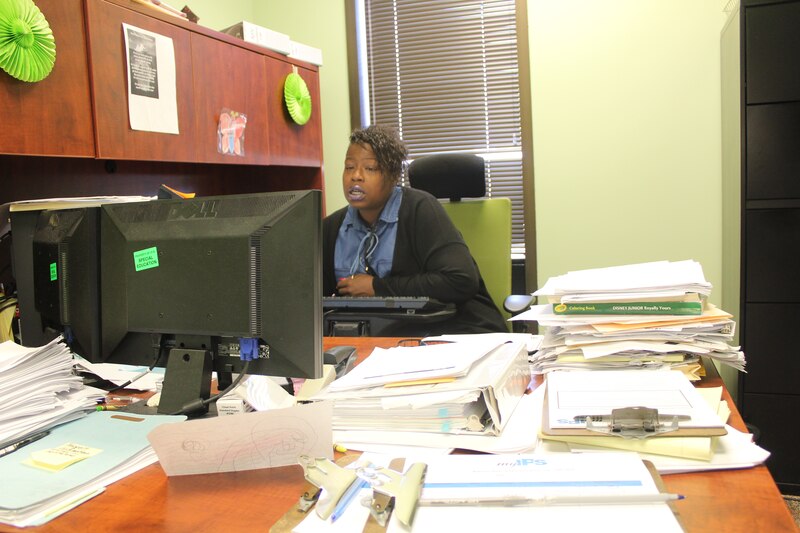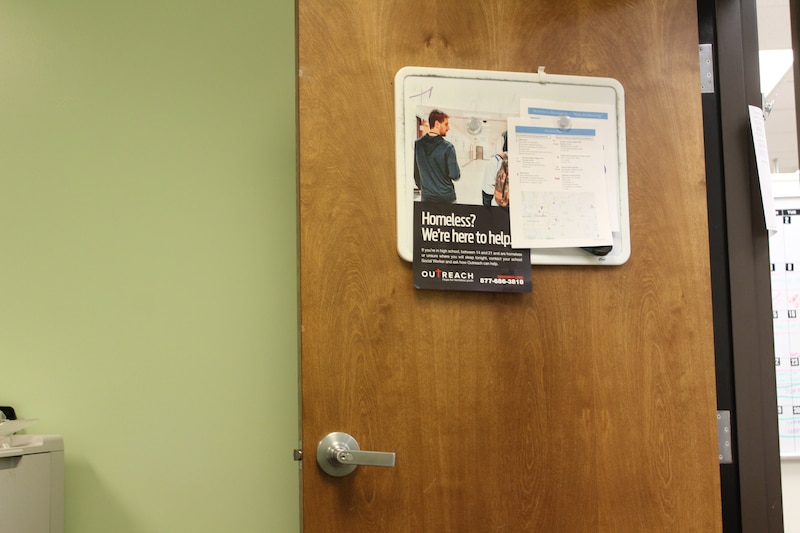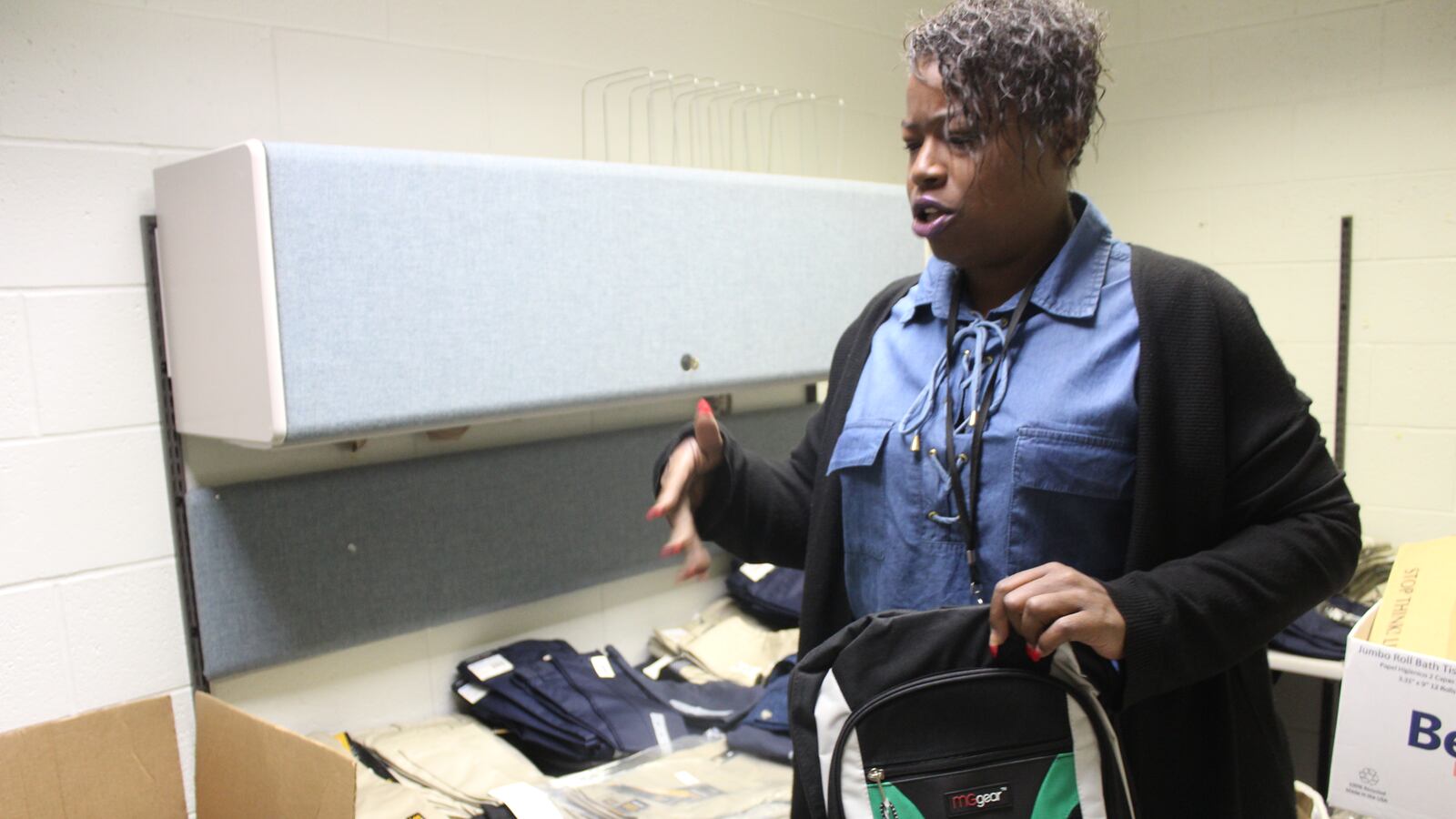“I’m just so frustrated,” the mother of two young daughters said, hands shaking and tears flowing down her face.
Charie Gibson tugged a tissue from a box wedged on the edge of her desk as she moved to sit next to the mother. Reaching over her paperwork, half-finished coloring pages, and the melted remains of a makeshift ice pack that an earlier visitor had needed, she offered her a tissue.
Gibson, 41, understood the other woman’s stress: The family was residing in a local emergency shelter, and the mother worried about where her girls would go to school, and whether their situation would make learning harder for them once they got there.
“Let that burden hang off my shoulders, not yours,” Gibson said. “We’re all just trying to do right by these babies.”
As the sole administrator responsible for serving the more than 1,000 homeless students in Indianapolis Public Schools, Gibson knows, perhaps better than anyone else in the district, the laws, policies, and resources students need to find stability. She also serves students in foster care.
She also knows firsthand the struggle that homeless families face: Gibson herself was homeless on 17 occasions in her adult life. She lived in Gary, Indiana, before moving to Indianapolis — and in both cities struggled to support her four children on a single income, which meant the family sometimes had to stay with friends, relatives and in shelters. She faced housing insecurity on and off up until just five years ago, one year after she started working for IPS as a temporary employee.
She said the experience inspires her to go the extra mile for the families and students who enter her office.
“I’ve sat on the other side of my desk many times, and there was always somebody telling me ‘no,’” said Gibson, who has been the district’s fulltime mandated McKinney-Vento liaison since 2015. “I try not to tell my parents no.”

The magic wand
McKinney-Vento liaisons have been offering help to homeless students and their families in districts nationwide for more than 30 years. But the 2015 revision of the federal education law, known as the Every Student Succeeds Act or ESSA, gave employees like Gibson new tools to ensure homeless students can stay in the school they had attended no matter where their housing situation leads them.
Now, district liaisons can also help unaccompanied minors get critical documents, such as birth certificates and social security cards, when a parent or guardian refuses to help. These documents are required for students to obtain drivers’ licenses and complete employment papers.
“It’s like an extra magic wand the law has given us, to be able to go out and advocate for these kids who don’t have anyone else to advocate for them,” Gibson said.
The updates to McKinney-Vento are helpful in a district like IPS, which has reported more homeless students than any other district in Indiana every year since at least 2005. Although the number of overall homeless students at IPS has been dropping the past two years, many district families not included in the homeless counts continue to face housing instability.
That’s, in part, because it can be hard to identify students experiencing homelessness. Often they are not staying outdoors or in a shelter, but rather living “doubled-up,” with another individual or family, according to data collected by the Coalition for Homelessness Intervention & Prevention, known as CHIP.
For unaccompanied students — minors who do not have secure housing and are living without a parent or guardian — a fear of government intervention may dissuade them from seeking help. Some, for example, experienced trauma while living in foster care. As a result, there are those who learn “what to say to prevent schools from identifying them,” said Amy Gibson, the youth planning manager for CHIP, upping the challenge for schools.
Identifying students, though, is the first step to providing assistance. That’s why Charie Gibson teaches IPS staff that homelessness can look different from living on the streets. In a presentation to IPS employees, for example, she noted how small details can often reveal a lot about someone’s housing situation: If they say they’re living with a relative or friend, for example, it might be worth taking a second look.
Unpacking trauma
Between meetings, Charie Gibson walks swiftly out the elevator doors and into the belly of the basement inside IPS’ headquarters, located at the corner of Walnut and Delaware streets.
It’s here where the district made a space for the piles of private donations — primarily school uniforms, such as khakis and polo shirts, and classroom supplies, including notebooks and backpacks — and other items purchased with federal money earmarked for students experiencing homelessness.
These supplies are a small way to alleviate already stressful circumstances for these families.
Research has shown that homelessness creates additional barriers to education, and that students who are homeless may have more trouble than their peers socializing and forming bonds since they fear picking up and leaving the next day.
That has academic implications, too. According to a report by state education leaders, 41% of homeless students in grades 3 through 8 passed the English portion of the state ISTEP exam, compared to the 64% of all students. Some 34% of homeless students passed the math section versus 58% overall. Additionally, students who end up homeless are more likely than their peers to have experienced sexual or physical abuse, or neglect, according to the same report.
While there is a growing conversation around providing trauma-informed care, which considers what individuals need to heal after traumatic experiences, those initiatives can only go so far when many districts, including Indianapolis, employ just one liaison.
“It comes down to a capacity issue,” said Amy Gibson, noting the hefty workloads homeless student coordinators already face.

Full circle
Gibson’s background also adds a level of patience and understanding that can take time for other advocates to develop, said Shawnta Beverly, vice president of mission impact for Coburn Place Safe Haven, an Indianapolis organization that provides women and children who have experienced domestic violence with support services and housing options. Beverly works with Gibson to coordinate services for the school-aged children that come to Coburn Place.
“She knows that our role is to be there to assist as needed, even when our clients don’t always make the best decisions,” Beverly said.
While Charie Gibson has no plans to leave her position anytime soon, she has begun to prioritize self-care as she wades through tales of extreme hardship. Reading or gardening help her relax.
And there are triumphs, she said, that keep her anchored to the job: With the mother of two daughters in her office on that day in July, she received a heartfelt “thank you” after she managed to guarantee the girls’ transportation to and from school. She also gave them colorful new back-to-school gear.
Gibson sees her work as a chance to instill in families the self-confidence she lacked when she and her family were experiencing homelessness — and the knowledge about the support services that are available to those without stable housing.
“I was a prideful parent. I didn’t want help. I wanted to do it on my own, not realizing I couldn’t,” Gibson said. “But when you come to me, you’re not leaving here until your children have what they need.”

